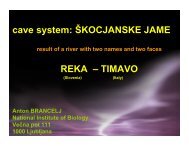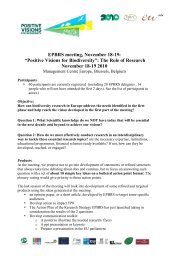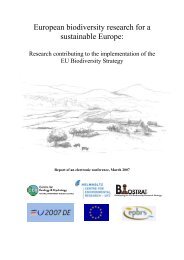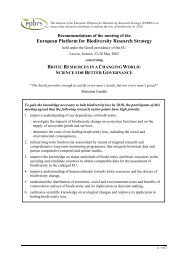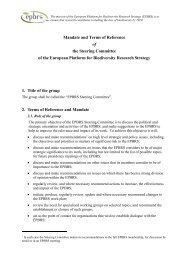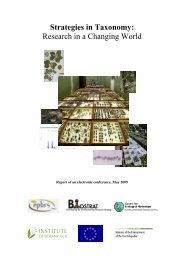Evaluation of the effectiveness of the New Instruments of ... - CORDIS
Evaluation of the effectiveness of the New Instruments of ... - CORDIS
Evaluation of the effectiveness of the New Instruments of ... - CORDIS
You also want an ePaper? Increase the reach of your titles
YUMPU automatically turns print PDFs into web optimized ePapers that Google loves.
Additionality 12<br />
Respondents were also asked what would have happened to <strong>the</strong>ir RTD project if an<br />
‘Integrated Project’ or a ‘Network <strong>of</strong> Excellence’ had not existed under <strong>the</strong> 6 th Framework<br />
Programme.<br />
While 5 % said not to have an opinion, 43 % stated it is (very) unlikely that a comparable<br />
project would have been submitted through o<strong>the</strong>r means. Looking at <strong>the</strong> different <strong>the</strong>matic<br />
areas, this share was considerably higher (75 % stating it is (very) unlikely) for ‘Food Quality<br />
and Safety’.<br />
A very small majority (52 %) answered it is (very) likely that a comparable project would have<br />
been submitted through o<strong>the</strong>r means. This proportion amounted to 67 % for <strong>the</strong>matic area<br />
‘Nanotechnologies and nanosciences, knowledge-based multi-functional materials and new<br />
production processes and devices’.<br />
Those respondents who answered it is (very) likely, were asked under which scheme<br />
<strong>the</strong>y think <strong>the</strong> project would have been submitted. On this question, 72 % <strong>of</strong> <strong>the</strong> respondents<br />
stated that <strong>the</strong> project would probably have been submitted as a traditional instrument under<br />
<strong>the</strong> 6 th FP. Results are shown in <strong>the</strong> chart below. No significant differences appeared when<br />
looking at <strong>the</strong> answers <strong>of</strong> successful and unsuccessful applicants.<br />
Chart 3.6 : Scheme under which <strong>the</strong> project might have been submitted alternatively –<br />
multiple answers were accepted (n=140)<br />
6%<br />
7% 6%<br />
30%<br />
75%<br />
6th FP - traditional instruments<br />
Regional funding scheme<br />
National funding scheme<br />
Own funds<br />
O<strong>the</strong>r<br />
Respondents who answered it is (very) likely <strong>the</strong>y would have submitted <strong>the</strong>ir proposal to<br />
o<strong>the</strong>r funding mechanisms, were also asked in how far <strong>the</strong> project would have been<br />
changed. Their answers appear in <strong>the</strong> chart below (next page).<br />
12 The concept <strong>of</strong> ‘additionality’ is used to justify <strong>the</strong> use <strong>of</strong> taxpayers money. The question to answer is what<br />
would have happened if no European public funds would have been made available : would <strong>the</strong> project or<br />
activities have taken place, and in which form ? Measuring additionality is consequently difficult, because it is<br />
trying to know what would have happened in ano<strong>the</strong>r situation.<br />
60



